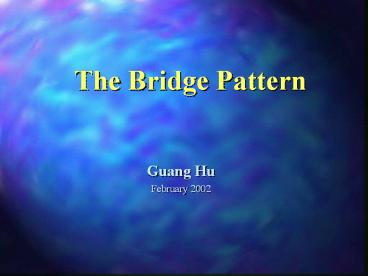The Bridge Pattern - PowerPoint PPT Presentation
1 / 15
Title:
The Bridge Pattern
Description:
Want to avoid a permanent binding between an abstraction and implementation. ... implementation of abstraction - can be configured at run-time ... – PowerPoint PPT presentation
Number of Views:26
Avg rating:3.0/5.0
Title: The Bridge Pattern
1
The Bridge Pattern
- Guang Hu
- February 2002
2
Overview
- Motivation
- Participants
- Structure
- Applicability
- Benefits
- Drawbacks
- Related Pattern
3
Motivation
4
Motivation
5
Motivation
6
Participants
- Abstraction (Entry)
- - define the abstractions interface
- - maintains a reference to an object of type
- Implementor
- Refined Abstraction (Task)
- - extends the interface defined by
Abstraction
7
Participants (continue)
- Implementor (persistentImp)
- - defines an interface for implementation
- classes. Typically, this Implementors
- interface provides only primitive menthod
- ConcreteImplementor (oraclePImp, AccessPImp)
- - implements the Implementors interface
8
Structure
9
Applicability
- Want to avoid a permanent binding between an
abstraction and implementation. - When abstractions and implementations should be
extensible through subclassing. - When implementation changes should not impact
clients.
10
Applicability (continue)
- When the implementation should be completely
hidden from the client. (C) - When you have a proliferation of classes.
- When, unknown to the client, implementations are
shared among objects.
11
Benefits
- Avoid permanent binding between an abstraction
and its implementation - Avoid nested generalizations
- Ease adding new implementations
- Reduce code repetition
- Allow runtime switching of behaviour
12
Drawbacks
- Double indirection
- - entry operation are implemented by
subclasses of PersistentImp class. Entry class
must delegate the message to a PersistentImp
subclass which implements the appropriate method.
This will have a slight impact on performance.
13
Consequences
- decoupling interface implementation
- - implementation of abstraction - can be
configured at run-time - - eliminate compile time dependencies on
implementation - - encourages layering
- improved extensibility
- - Abstraction Implementer - can be extended
independently - hiding implementation details from clients
14
Related Pattern
- Abstract Factory- The Abstract Factory pattern
can be used by the Bridge pattern to decide which
implementation class to instantiate for an
abstraction object. - Adapter
15
Thank you































